Synology DS413
This model is equipped in a quite new case
which was first introduced in the previous NAS of Synology. It is optimized for
lower noisiness, using rubber pads for HDD and the front panel. The case is
20x23.3x16.5 cm in size. Most of its exterior panel is made of black plastic
but the rear is made of metal.
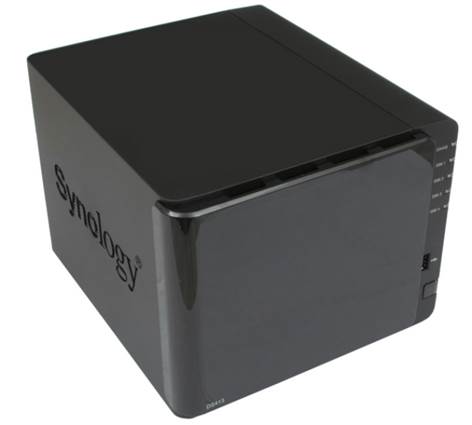
The
case is 20x23.5x16.5 cm in size
HDD bays are covered by a smooth plastic
panel but the rest is dim and practical. On the right of the front panel, we
can see the system and the HDD parameters, a 2.0 USB port and a LED integrated
power button.
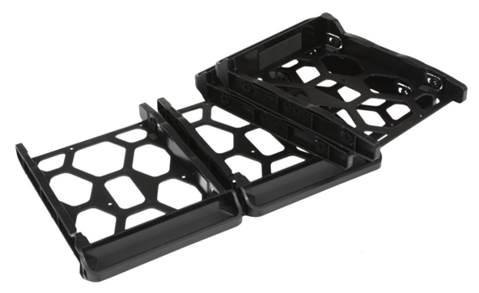
HDD
bays
HDD is installed into a frame which is
compatible with both model patterns. The frame is secured in the bays by
plastic keys.
There are vent grids in the front, buttons
and side panels, but we doubt that whether these grids efficient? Especially
for HDD
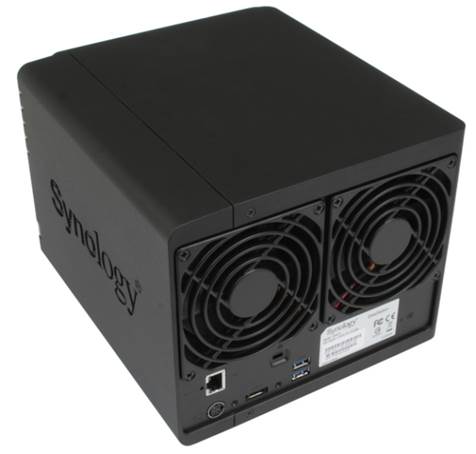
90mm
fans at the back
There are two 90mm fans at the back. The
rear panel also provides a power connection, a Gigabit Ethernet port with
indicators, an eSATA, two USB 3.0 connections and hidden reset button. The
eSATA interface can be used with the expanded module of Synology to increase
supported the HDD (these modules are accompanied by a cable and screw.)
This case design is good and has many
features, although there is no button for saving data via USD and the front USB
panel is just the version 2.0. They, however, are just minor weaknesses.
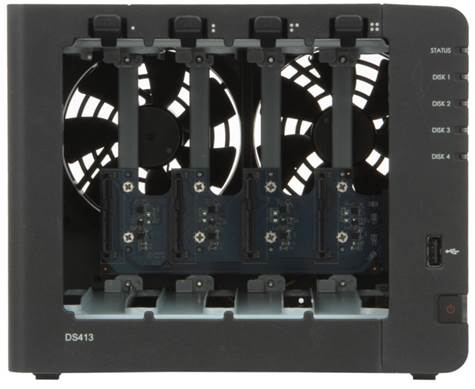
The
HDD is installed from the outside
The users do not intend to give up on NAS
because the HDD is installed from the outside. There is no maintainable part
inside. Nevertheless, if you want a closer view, you can remove the plastic
case to find out a metal frame at the bottom. There are three PCB integrated
with them: one main PCB, a backplane for HDD, as I/O unit with the traditional
port. They are connected via PCIe slot without flexible cables.
Synology uses the PPC platform in its
contemporary products. It used to be installed in the top-end NAS years ago,
but after that, it was replaced by Atom from Intel NAS based on Atom of
Synology, which will be mentioned below.
The hardware platform was improved since
then. Freescale Qorl P1022 processor integrated two core e500 while the clock
rate was maintained at the level of 1.067 MHz. The updated version of the ship
is highlighted by DDR3 support, so DS413 is equipped with 1GB from DDR3 SDRAM.
The flash memory is just used for installation and OS startup, so its capacity
is just 8 MB. Four SATA ports are based on a Marvell 88SX7042 chip. The USB controller
integrated CPU is just version 2.0. Therefore, the two USB 3.0 ports are based
on NEC D720200 chip. The network controller works together with a Realtek
RTL8211E chip.
Synology DS412+
The DS412+ is the top 4-disk NAS from
Synology in the desktop form-factor. Introduced in spring 2012 and based on x86
platform, It is the most preferable choice in that product category. As we have
mention above, DS412+ and DS413 are completely the same except for two Gigabit
Ethernet ports.
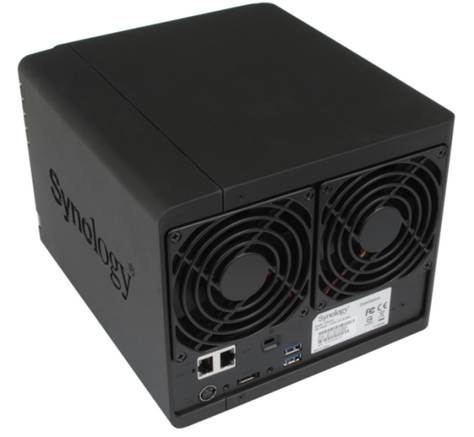
DS412+
is configured differently
However, the DS412+ is configured
differently inside. It has an Intel Atom D2700 processor clocked at 2.13 GHz.
With two cores and HT support, it can process four execution threats
simultaneously. The CPU works together with an ICH10R chip, providing SATA and
USB 2.0 port. DS412+ is equipped with a 1 GB system memory in a DDR3 SO-DIMM.
It can be replaced by a larger one in capacity, but this upgrade will violate
the warranty rules. A couple of Intel 82574L chips are used as a network
controller. The external eSATA port is based on an additional Sil3531 chip,
which seems to be more compatible with port multiplications (used in the
expansion modules of Synology) than Intel chip. A NEX D720200 is added to
support the USB 3.0. The PCB contains a 128MB flash disk with USB interface. It
is used to load some exclusive software of Synology because the BIOS of this
platform is not used for that purpose. By the way, OS is a 64-bit version. It
is very hard to tell that whether this selection is necessary, but you should
keep this in mind.
Specifications
We can see that
they are not only different in terms of the processors but also in some other
specifications. All of them support SATA 3 Gbit/s although the competitive
products have provided Gbit/s already. However, this is almost not important
for NAS applications.
The senior model is not as good as the top
solutions from other companies because it lacks video output and has fewer USB
2.0 and eSATA ports, but in fact, it is offset by the existence of the
expansion module of Synology.
Each NAS features a quiet and efficient
cooler. The HDD temperatures are not higher than 40 to 43°C during our tests. When
set on the table, a NAS is not audible among the sound of daytime noises.
|
DS413j
technical specs
·
Processor: Marvell 88F6282, ARM, 1.6 GHz
·
Memory: 512 MB DDR3
·
SATA: Marvell 88SX7042
·
Network: 1x1000
·
Port: 2x USB 2.0
·
Expanding via eSATA: not available
DS413 technical specs
·
Processor: Freecale QorlQ P1022, PPC, 2C,
1.067 GHz.
·
Memory: 1 GB DDR3
·
SATA: Marvell 88SX7042
·
Network: 1x1000
·
Ports: 1xUSB 2.0, 2x USB 3.0, 1x eSATA
·
Expansion via eSATA: DX513/DX213 (independent
partition)
DS412+ technical specs
·
Processor: Intel Atom D2700, x86, 2C4T, 2.13
GHz
·
Memory: 1 GB DDR3
·
SATA: ICH10R
·
Network: 2x1000
·
Ports: 1x USB 2.0, 2x USB 3.0, 1x eSATA
·
Expansion via eSATA: DX513/DX213 (independent
partition)
|